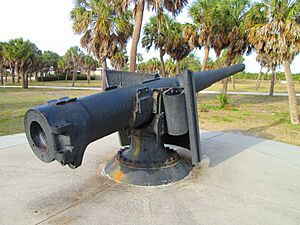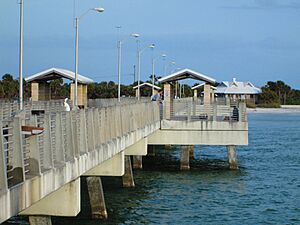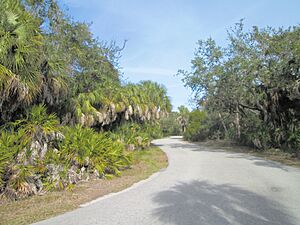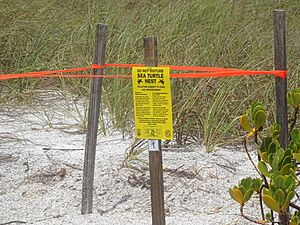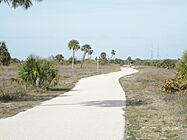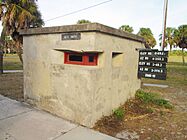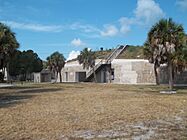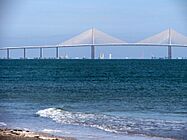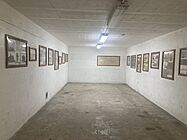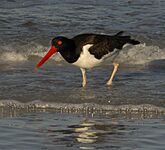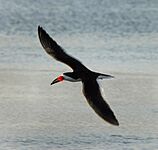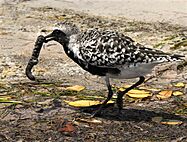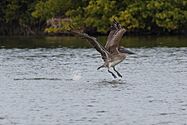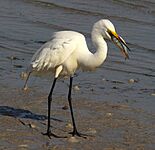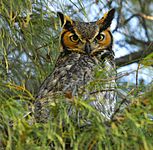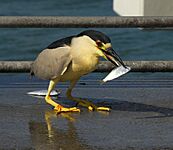Fort De Soto Park facts for kids
Quick facts for kids Fort De Soto |
|
|---|---|
| Part of Endicott Period Coastal Defense | |
| Mullet Key, Pinellas County, Florida | |
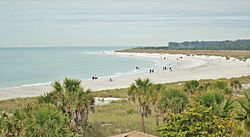
One of the beaches of Fort De Soto Park (2012)
|
|
| Coordinates | 27°36′56″N 82°44′09″W / 27.615499°N 82.735902°W |
| Type | Seacoast defense |
| Site information | |
| Owner | Pinellas County |
| Open to the public |
Yes |
| Site history | |
| Built | 1898–1906 |
| Built by | United States Army Corps of Engineers |
| In use | 1898–1910 |
| Materials | Reinforced concrete |
| Events | Spanish–American War |
|
Fort De Soto Batteries
|
|
| Lua error in Module:Location_map at line 420: attempt to index field 'wikibase' (a nil value). | |
| Location | 8 miles (13 km) South of St. Petersburg, Mullet Key, Pinellas County, Florida |
| NRHP reference No. | 77000407 |
| Added to NRHP | December 2, 1977 |
Fort De Soto Park is an amazing county park in Pinellas County, Florida. It's located just south of St. Petersburg, Florida. The park is made up of five beautiful islands, also called keys. These islands are Madelaine Key, St. Jean Key, St. Christopher Key, Bonne Fortune Key, and the biggest one, Mullet Key.
You can reach these islands by driving over bridges and causeways from the mainland. There's a small toll to enter the park. Fort De Soto Park is famous for its history, especially its old military forts. You can still see parts of these forts and visit a museum to learn more. The park also has two fishing piers, lovely beaches, picnic spots, and trails for hiking, biking, and kayaking. You can even take a ferry from here to Egmont Key State Park. It's also a great place for birdwatching, being part of the Great Florida Birding Trail.
Contents
History of Fort De Soto Park
Early Days of the Islands
Long ago, from about 1000 to 1500 ACE, the Tocobaga Native Americans lived in the area where Fort De Soto Park is now. They lived on Mullet Key and other nearby islands. They mostly ate seafood like fish, clams, and oysters from the Gulf of Mexico. They also gathered plants and hunted small game.
In 1529, a Spanish explorer named Pánfilo de Narváez explored these islands. Ten years later, Hernando De Soto landed near Tampa Bay. His arrival led to Spain taking control of Florida.
Military History of the Fort
In 1849, US Army engineers surveyed the area. One of them was Robert E. Lee, who later became a famous general. They suggested fortifying Egmont Key and saving other islands, like Mullet Key, for military use. Mullet Key became a military reservation that same year. However, no forts were built before the American Civil War.
During the Civil War, Confederate soldiers briefly took over Egmont and Mullet keys. They soon left for Tampa. The Union Army then occupied the islands by mid-1861. The islands were important because they were close to the main channel into Tampa Bay. This helped the Union Navy blockade Tampa Bay. The lighthouse on Egmont Key was used as an observation tower. The Navy also set up a camp on Egmont Key for people who supported the Union.
After the Civil War, the military decided to keep Mullet Key as a military reservation. In 1885, people in St. Petersburg wanted to extend a railway to Mullet Key. They hoped to use it for ocean-going ships. But the Secretary of War said no because the island was reserved for the military.
Fortifications were finally built on the islands when the Spanish–American War began.
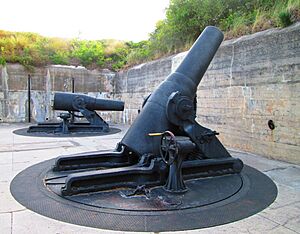
In 1889, a quarantine station was built on Mullet Key. It was called Mullet Key Quarantine Station. Its job was to check people arriving on ships from other countries. By 1925, it had fifteen buildings. The station closed in 1937.
The main military base on Mullet Key was named Fort De Soto in 1900. It was named after Hernando de Soto. This fort, along with Fort Dade on Egmont Key, was built to protect Tampa Bay. Construction of Fort De Soto started in 1898 and finished in 1906. The fort had artillery and 12-inch coast defense mortar batteries, called Batteries Laidley and Bigelow. The base had 29 buildings, including barracks, a hospital, and a mess hall. It even had brick roads and a small railroad to move supplies.
Fort De Soto was active from 1898 to 1910. Soldiers lived there, but mosquitoes were a big problem, and summers were very hot. In 1910, most soldiers moved to Fort Morgan, Alabama. Only a small group stayed to look after the fort. During World War I, more caretakers were there. In 1917, four of Fort De Soto's mortars were moved to California.
In 1922, the Army decided to close Forts De Soto and Dade. By 1926, most of the guns were removed. Only four large mortars at Battery Laidley remained. The forts were supposed to be reopened if there was another war, but that never happened. Several tropical storms and hurricanes damaged the buildings. Battery Bigelow was destroyed in 1932. The Army tried to sell the fort, but no one was interested. In 1938, Pinellas County bought the land on Mullet Key for $12,500.
From Military Base to Park
After Pinellas County bought Mullet Key, they leased some land and buildings to Percy L. Roberts. He wanted to start a business there.
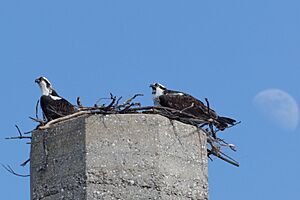
Roberts planned to run a boat service to Mullet Key. This would bring fishermen and sightseers to the island. Fishermen could enjoy the great fishing, and sightseers could explore the old fort ruins and beaches. He also wanted to open a hotel and restaurant. He imagined a place where groups could come for fishing, sightseeing, and eating "fried mullet."
With help from Charles R. Carter, Roberts started his plan. A boat called the Hobo began taking passengers daily from St. Petersburg. People could also fly small planes to a cleared strip on the island. Roberts renovated an old building into the Mullet Key Lodge. It was a simple place, but you could get a good night's sleep and hearty meals.
A writer for the St. Petersburg Times wrote in 1939 that the county had done a "fine thing" by opening Mullet Key to visitors. He said people could take a boat, enjoy a fish dinner, and explore the beaches and the old fort.
World War II Bombing Range
Mullet Key Lodge was doing well, but its success was short-lived. In less than two years, the US War Department wanted the island back. They needed it as a bombing range for the U.S. Army Air Corps during World War II.
In June 1941, the federal government bought Mullet Key back from Pinellas County. It became a sub-post of MacDill Field and was used for bombing practice throughout World War II.
Fort De Soto Becomes a County Park
After World War II, the U.S. Army Air Forces no longer needed Mullet Key. In 1948, it was sold back to Pinellas County, along with other nearby islands. The county paid $26,495.54 for the land. County officials immediately decided to make Fort De Soto and Mullet Key a public park. Soon, boats started taking visitors to the island again.
In 1962, a toll road called the Pinellas Bayway was finished. This meant people could drive their cars directly to the island. On December 21, 1962, Fort De Soto Park officially opened. The park has grown a lot since then. The old quartermaster storehouse was rebuilt into a museum. On December 2, 1977, the Fort De Soto batteries were added to the National Register of Historic Places. The park is special because it has the only four 12-inch M1890 mortars and two 6-inch Armstrong guns of their kind left in the United States.
The Quartermaster Storehouse Museum
The Quartermaster Storehouse Museum is a copy of the original building from 1900-1906. It was rebuilt in 1999 using old photos and Army records. Park staff built the wooden building, adding modern features like air conditioning and a fire system. The original military post had 29 buildings, including a hospital, barracks, and a bakery. Park staff and volunteers wanted to bring some of that history back. The museum opened on November 11, 2000.
Inside, you'll see a mannequin of a quartermaster, surrounded by supplies he would have given to soldiers. Wall panels tell the story of the area, from the Spanish explorers meeting the Tocobaga Indians to the Spanish–American War era. There are also display cases with artifacts found in the park, like a practice bomb from World War II, military badges, and old items like a woman’s dress. An interactive touch-screen lets you explore more information, photos, and videos about the fort's history, especially the powerful 12-inch mortars.
Fun Things to Do at the Park
Fort De Soto Park is open all year and has lots of cool things to do:
- You can fish in the shallow waters, which are great for wading.
- There are two piers for fishing. Both have places to buy bait, tackle, and food.
- Many picnic areas are perfect for a family meal outdoors.
- You can explore the historic Fort De Soto, built in 1898.
- Visit the Quartermaster Storehouse Museum to learn about the fort's past.
- Enjoy two swimming areas: North Beach and East Beach. North Beach has been called "America's Best Beach" many times!
- There's an 800-foot boat ramp for launching boats.
- A camping area offers a camp store, modern restrooms, and a laundry room.
- Grab a snack or a souvenir at the gift shop near the old fort.
- Ride your bike on the seven-mile multi-purpose trail.
- Explore the 2¼ mile canoe trail.
- Walk along the barrier-free nature trail.
- Let your pets play at the Paw Playground.
- Take a ferry to Egmont Key, home to Egmont Key State Park.
How the Islands Were Formed
Mullet Key is a barrier island. These islands are formed by waves and currents. What's special about Mullet Key is its shape. It has two parts that meet at a right angle. One part faces the Gulf of Mexico and is shaped by ocean waves. The other part faces the entrance to Tampa Bay and is shaped by the strong tidal currents.
Because waves, currents, and storms are always moving sand around, the shape and size of Mullet Key change over time. In 1970, the five islands of the park had a total land area of about 970 acres. By 2014, they had grown to about 1140 acres.
Changing Islands: South Bunces Key
In the late 1970s, a sandbar off the north end of Mullet Key grew into a new island called South Bunces Key. It grew quickly and became covered with plants. Eventually, it connected to Mullet Key at both ends. But storms in the early 2000s eroded South Bunces Key. By 2016, it had disappeared, and the part of Mullet Key behind it started to erode too. Recently, a new sandbar, called Outback Key, has formed in a similar spot and has connected to Mullet Key.
Nature and Wildlife
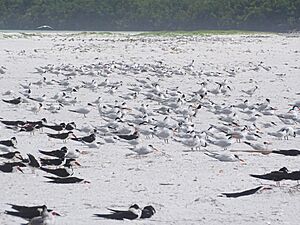
Fort De Soto Park is a fantastic place for nature lovers. It has different types of environments, like mangroves and hammocks. Over 328 kinds of birds have been seen here! Large parts of North Beach are protected for birds to nest and for migrating birds to rest. However, some birds like the mangrove cuckoo and prairie warbler no longer breed here. This is due to things like losing their homes and an increase in brown-headed cowbirds, which lay their eggs in other birds' nests.
Like many beaches in this area, the park is also home to endangered loggerhead sea turtles. These turtles come to the beaches to lay their eggs.
Australian pines were brought to Florida after 1890 to act as windbreaks. These trees can handle salt and poor soil. But they have spread and taken over areas where native plants used to grow. Australian pines have shallow roots, so they can fall easily in storms. They also make beaches more prone to erosion. Their roots can also make it hard for sea turtles to dig nests. Now, Australian pines are considered a harmful plant in Florida. The park plans to remove about ten percent of these trees each year, starting with those closest to the water. The Florida Fish and Wildlife Conservation Commission (FWC) began removing them from North Beach in 2015.
Images for kids
-
A view of the Sunshine Skyway Bridge from Fort De Soto
- Birds of Fort De Soto Park
-
Reddish egret
(Egretta rufescens) -
American oystercatcher
(Haematopus palliatus) -
Black skimmer
(Rynchops niger) -
Black-bellied plover
(Pluvialis squatarola) -
Brown pelican
(Pelecanus occidentalis) -
Great egret
(Ardea alba) -
Great horned owl
(Bubo virginianus) -
Black-crowned night heron
(Nycticorax nycticorax) -
Marbled godwit
(Limosa fedoa)
See also


